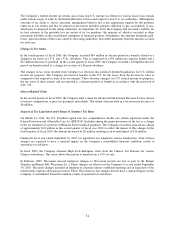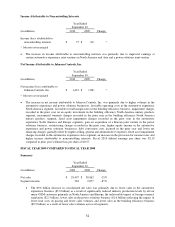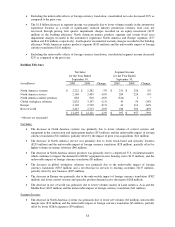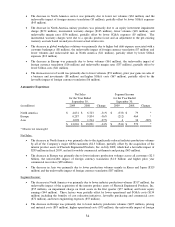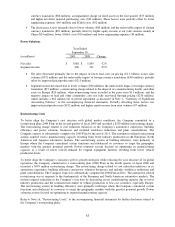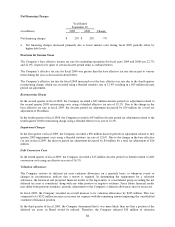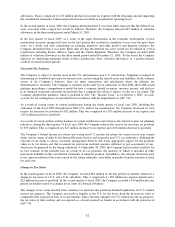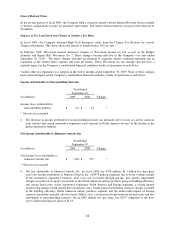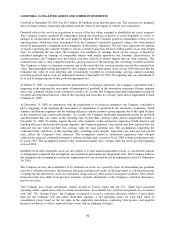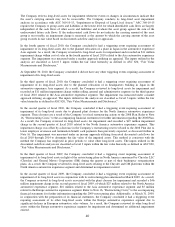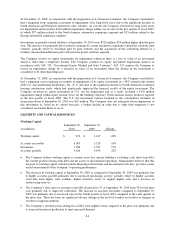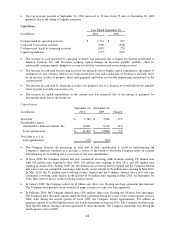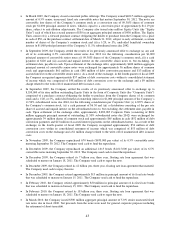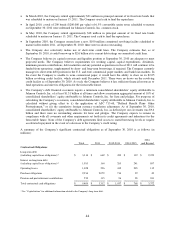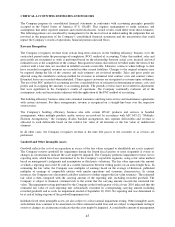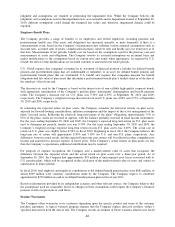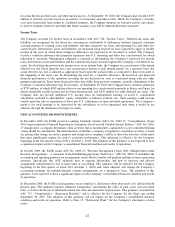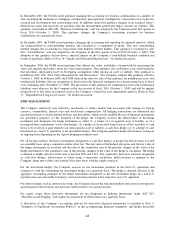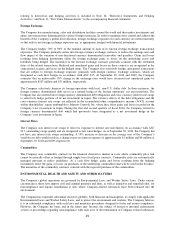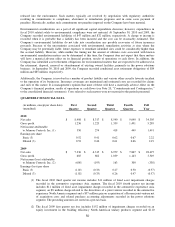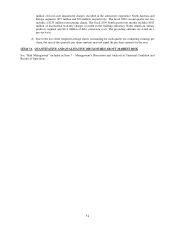Johnson Controls 2010 Annual Report Download - page 41
Download and view the complete annual report
Please find page 41 of the 2010 Johnson Controls annual report below. You can navigate through the pages in the report by either clicking on the pages listed below, or by using the keyword search tool below to find specific information within the annual report.
41
At December 31, 2008, in conjunction with the preparation of its financial statements, the Company concluded it
had a triggering event requiring assessment of impairment of its long-lived assets due to the significant declines in
North American and European automotive sales volumes. As a result, the Company reviewed its long-lived assets
for impairment and recorded a $110 million impairment charge within cost of sales in the first quarter of fiscal 2009,
of which $77 million related to the North America automotive experience segment and $33 million related to the
Europe automotive experience segment.
Investments in partially-owned affiliates at September 30, 2010 were $728 million, $10 million higher than the prior
year. The increase was primarily due to positive earnings by certain automotive experience and power solutions joint
ventures, partially offset by dividends paid by joint ventures and the acquisition of the controlling interest in a
formerly unconsolidated Korean joint venture in the power solutions segment.
The Company reviews its equity investments for impairment whenever there is a loss in value of an investment
which is other than a temporary decline. The Company conducts its equity investment impairment analyses in
accordance with ASC 323, ―Investments-Equity Method and Joint Ventures.‖ ASC 323 requires the Company to
record an impairment charge for a decrease in value of an investment when the decline in the investment is
considered to be other than temporary.
At December 31, 2008, in conjunction with the preparation of its financial statements, the Company concluded it
had a triggering event requiring assessment of impairment of its equity investment in a 48%-owned joint venture
with U.S. Airconditioning Distributors, Inc. (U.S. Air) due to the significant decline in North American residential
housing construction starts, which had significantly impacted the financial results of the equity investment. The
Company reviewed its equity investment in U.S. Air for impairment and as a result, recorded a $152 million
impairment charge within equity income (loss) for the building efficiency North America unitary products segment
in the first quarter of fiscal 2009. The U.S. Air investment balance included in the consolidated statement of
financial position at September 30, 2010 was $53 million. The Company does not anticipate future impairment of
this investment as, based on its current forecasts, a further decline in value that is other than temporary is not
considered reasonably likely to occur.
LIQUIDITY AND CAPITAL RESOURCES
Working Capital
September 30,
September 30,
(in millions)
2010
2009
Change
Working capital
$
919
$
1,147
-20%
Accounts receivable
6,095
5,528
10%
Inventories
1,786
1,521
17%
Accounts payable
5,426
4,434
22%
The Company defines working capital as current assets less current liabilities, excluding cash, short-term debt,
the current portion of long-term debt and net assets of discontinued operations. Management believes that this
measure of working capital, which excludes financing-related items and discontinued activities, provides a more
useful measurement of the Company’s operating performance.
The decrease in working capital at September 30, 2010 as compared to September 30, 2009 was primarily due
to higher accounts payable primarily due to increased purchasing activity, partially offset by higher accounts
receivable from higher sales volumes, higher inventory levels to support higher sales and a decrease in
restructuring reserves.
The Company’s days sales in accounts receivable decreased to 55 at September 30, 2010 from 58 for the prior
year primarily due to improved collections. The increase in accounts receivable compared to September 30,
2009 was primarily due to increased sales in the fourth quarter of fiscal 2010 compared to the same quarter in
the prior year. There has been no significant adverse change in the level of overdue receivables or changes in
revenue recognition methods.
The Company’s inventory turns during fiscal 2010 were slightly lower compared to the prior year primarily due
to increased inventory production to meet increased demand.


